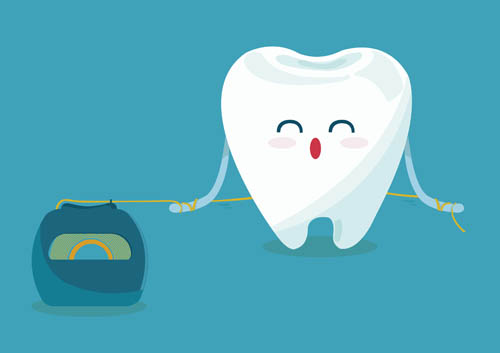March 10th, 2017

Of all the dental hygiene techniques you can use at home to promote clean teeth and good oral health, flossing is likely to be the one that troubles most people. It can be viewed as confusing and time-consuming, but when you learn how to floss your teeth correctly, you’ll find it’s easy to do on a daily basis.
Proper flossing techniques are vital to the health of your teeth and gums. These tips will help you with the correct flossing procedures. Likewise, Dr Karina Gregg and our team can also help you learn how to floss effectively and efficiently.
Steps to Flossing Your Teeth Properly
- Choosing Dental Floss. You can find dental floss in various flavors, as well as waxed or unwaxed. If the floss you use seems to get stuck between your teeth, switch to waxed to make it easier.
- Flossing “Helpers.” Beginner flossers who have trouble coordinating the floss and the movements of their hands can use a floss holder to help them get in and around teeth.
- Preparing the Floss. Cut an 18-inch piece of floss to use for flossing a few teeth. This allows you to make progress before you must stop and cut another piece of floss.
- How to Hold It. Wind the ends around your middle fingers. Hold the floss taut, pinching each side with your thumbs and index fingers. Leave a couple inches free in the middle.
- The Process of Flossing. Use your index fingers to guide the floss toward your gum line. Bring it down between the teeth with a zigzag motion. Hold the floss in a C-shape around the tooth, and move it up and down along the side.
- Where to Floss. Use a clean portion of the floss to clean around and in between each tooth. Don’t forget about the molars in the back of your mouth, too!
Flossing: A Vital Part of Oral Care
Periodontal disease begins at the gum line; this is where flossing comes in. Regular flossing helps you remove plaque from the gum line and between your teeth to avoid gum disease. In conjunction with daily brushing and twice-a-year visits to San Elijo Dental, floss each day to maintain good oral hygiene and overall health. Gum disease can have an impact on your general health, but it doesn't have to. This easy-to-prevent condition can be avoided with regular visits to our San Marcos, CA office and daily flossing. Allow our team to partner with you in maintaining a bright, shiny smile and good oral health.
March 3rd, 2017

Capturing the Moment
At San Elijo Dental we know that just about anyone who has taken on the challenge of planning her own wedding could tell you how important the little details can be. Things like having complementary colors, the right location, show-stopping flowers, and delicious food are all a big part of planning your spring wedding. Another little detail that has a big "I do" related role? Your smile.
Whether you’re the bride, or an attendant, looking your best when you tie the knot (or help someone tie the knot) is essential. If your teeth aren’t ready to make an entrance, turning to one of the many available teeth whitening solutions is a great option.
Reliable Solutions
Before the wedding day arrives, you should take your smile into consideration. If diet and daily wear-and-tear have caused your teeth to lose their original luster, our team can help! In-office procedures do cost more than kits you use at home, but with an in-office treatment, you benefit from a professional taking proper care of your teeth.
In addition, relying on our office to handle teeth whitening before the wedding can give you access to trustworthy advice on how to keep your teeth looking their best for a longer period of time. It’s common for someone experienced in assisting people with their oral health to suggest investing in an in-office whitening technique and then following up with a teeth-whitening kit at home.
This is a season of new beginnings and beauty. Take the time to bring out your most beautiful smile before the big day. Don’t let your smile hold you back on your wedding. With our in-office teeth whitening, you can be sure that you’ll be more confident and comfortable interacting with friends and family. So remember, when in need of some quality oral care in San Marcos, CA to think of Dr Karina Gregg!
February 24th, 2017

Dr Karina Gregg and our team know it can be easy to underestimate the significance of baby teeth. At San Elijo Dental, we sometimes meet parents who assume that since their child's baby teeth, also known as primary teeth, eventually fall out and are replaced, they are less important. But did you know baby teeth serve purposes other than biting, chewing, and digesting food properly?
Baby teeth are essential not only for your child’s language development, but they also serve other important functions, like contributing to the normal development of your child’s jaw bones and facial muscles. Baby teeth also reserve space for your child’s future permanent teeth.
So, when do baby teeth fall out?
A baby tooth is intended to remain in your child’s mouth until the permanent tooth underneath it is ready to take its place. Sometimes, either due to a tooth being knocked out accidentally or being removed because of tooth decay, kids lose baby teeth before the permanent teeth are ready to erupt. If a tooth is lost, the teeth on either side of the open space may possibly push into the open space. The result? There may not be enough room for the permanent tooth when it is finally ready to erupt.
If you have any questions about your toddler’s teeth, or if your child is experiencing issues that concern you, please give us a call to set up an appointment at our convenient San Marcos, CA office.
February 17th, 2017

With advancements in prosthetic dentistry, patients are now able to wear dentures that are comfortable, natural looking, and long lasting. There are different options to choose from that will meet your individual needs, whether you have a few teeth missing or have lost all of your teeth. Dr Karina Gregg will be able to help you decide which denture option is best for you.
Partial Dentures
Patients who receive partial dentures have some of their original teeth still in place and therefore only need a partial to replace the missing teeth and keep their existing teeth from moving. It also makes sense that patients need them to be able to eat comfortably. All dentures are made from porcelain or plastic and are made with comfort in mind.
Complete Dentures
If you have suffered from complete tooth loss, you would typically receive complete dentures. Immediately after you have your teeth extracted you will leave the dentist office with a set of temporary dentures. These will be worn for a few months while your mouth heals. After this initial wait time, your conventional or permanent dentures will be ready to be fitted.
Implant-Supported Dentures
Implant-supported dentures involve a more invasive procedure, but are also permanent. A select number of implants are placed into the jaw. The denture is then attached to the implant posts. You will be able to chew normally and maintain normal dental hygiene, like brushing and flossing.
Dr Karina Gregg will be able to advise on which kind of denture would be the best based on your individual needs. Contact our San Marcos, CA office to schedule an appointment!







 Website Powered by Sesame 24-7™
Website Powered by Sesame 24-7™